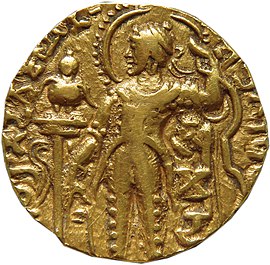Samudragupta

Samudragupta (reigned 335–375 / 80), who bore the titles of Maharajadhiraja ("King of Kings") and Chakravartin (literally: "Radandreher", meaning: "Universal ruler"), was the second great ruler of the North Indian Gupta dynasty . The then capital of the Gupta empire was Pataliputra near the present-day city of Patna in the Indian state of Bihar ; another important city was Prayaga, today's Prayagraj in the Indian state of Uttar Pradesh .
family
Samudragupta was the son of Chandragupta I (ruled approx. 320-335) and the Licchavi Princess Kumaradevi . He was the father of Chandragupta II (ruled approx. 375 / 80–413 / 5) and the grandfather of Kumaragupta I (ruled approx. 415–455).
swell
Little is known of his life and character; We are somewhat better informed of his victorious campaigns and military conquests from two inscriptions in Prayagraj and Eran . In addition, there are various coin inscriptions that - like the other inscriptions - have propagandistic traits. He and his family were members of the warrior caste ( kshatriyas ). The coin portraits show him as a strongly built warrior, but also as a poet and as a musician who loved to play the vina .
religion
Samudragupta seems - after centuries of intellectual predominance of Buddhism - to have turned to Hinduism like his father. The coin images show him as a devoted admirer of the Hindu god Vishnu , who, however, is not depicted himself, but is represented by the sun eagle Garuda , who is usually enthroned on top of a high column. He also revived the horse sacrifice ritual ( ashvamedha ) mentioned in the Vedas . However, nothing is known of Samudragupta's temple foundations (see Gupta Temple ) or any other activity as builders of religious or secular buildings.
In all of this, Buddhism - as far as we know - was not discriminated in any way, but was also given foundations; the traditional religious rights and freedoms were not affected. A Chinese report mentions that he gave Meghavanna , the king of Sri Lanka , permission to build a Buddhist monastery in Bodhgaya .
history
Although Samudragupta probably had older brothers, his father Chandragupta I chose him as his successor; possibly he had to deal with palace revolts , from which he emerged victorious. During his long reign he enlarged his father's empire many times over, rejecting a policy of total submission to his opponents; rather, he preferred a system of largely independent but tributary vassal states. Already in his youth he conquered the nearby kingdom of Panchala . Later he turned south and probably came as far as Kanchipuram . This was followed by several campaigns in northwest India a. a. against the Saken and against the Kushan -Reich.
meaning
Samudragupta was considered invincible and in fact not a single military defeat is known; for many he is the "Indian Napoleon". With his campaigns and with a developed system of coins he created a huge economic area; but also with his penchant for music and poetry, he laid the foundation for the “golden age” of India under his two successors.
literature
- Hermann Kulke , Dietmar Rothermund : History of India. From the Indus culture to today. 2nd, updated edition of the special edition. CH Beck, Munich 2010, ISBN 978-3-406-60414-0 .
- Fred Virkus: Political structures in the Gupta empire . (300–550 AD) (= Asia and Africa Studies at the Humboldt University in Berlin. 18) Harrassowitz, Wiesbaden 2004, ISBN 3-447-05080-2 .
Web links
- Biography Samudragupta (Engl.)
- Short biography Samudragupta (Engl.)
- History of the Gupta Empire - Samudragupta (engl.)
- partially destroyed text of the pillar inscription Prayagraj (Engl.)
- Coins Samudragupta - Photos and information (Engl.)
| personal data | |
|---|---|
| SURNAME | Samudragupta |
| ALTERNATIVE NAMES | Maharajadhiraja |
| BRIEF DESCRIPTION | Ruler in the north Indian empire of the Gupta (335–375 / 80) |
| DATE OF BIRTH | 4th century |
| DATE OF DEATH | 4th century |